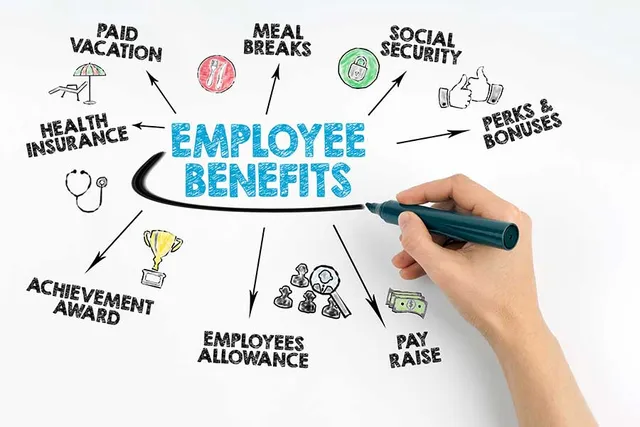An effective employee benefits plan is crucial for attracting and retaining talented employees, promoting employee well-being, and ensuring job satisfaction. Creating an employee benefits plan requires careful planning, analysis, and consideration of various factors.
Find out the in-depth, step-by-step process of creating a group benefits insurance and employee benefits plan.
1. Assessing Needs and Objectives

The first step in creating an employee benefits plan is to assess the needs and objectives of both the organization and its employees. This involves conducting surveys, interviews, and focus groups to gather information about the specific benefits employees value and the organization’s goals. By understanding the needs, preferences, and expectations of employees, the organization can design a benefits plan that aligns with its overall objectives.
2. Researching and Analyzing Options
Once the needs and objectives have been identified, the next step is to research and analyze the available options for employee benefits. This includes exploring different types of benefits, such as health insurance, retirement plans, paid time off, flexible work arrangements, wellness programs, and educational assistance. It is essential to consider the cost, feasibility, and legal requirements associated with each option. Additionally, benchmarking against industry standards and competitors can provide insights into what benefits are commonly offered in the market.
3. Designing the Benefits Package

Based on the needs assessment and research, the organization can proceed to design the employee benefits package. This involves selecting the specific benefits to be included, determining the level of coverage or contribution, and establishing eligibility criteria. The benefits package should be tailored to meet the diverse needs of the workforce while aligning with the organization’s budget and strategic objectives. It is essential to strike a balance between offering attractive benefits and managing costs effectively.
4. Consulting with Stakeholders
Creating an employee benefits plan requires collaboration and input from various stakeholders, including human resources, finance, legal, and employee representatives. Consulting with these stakeholders ensures that all perspectives are considered and that the benefits plan complies with legal and regulatory requirements. Involving employee representatives or conducting focus groups can help gather feedback and ensure that the benefits plan meets the expectations of the workforce.
5. Communicating the Benefits Plan

Effective communication is key to the successful implementation of an employee benefits plan. Once the plan has been designed, it is crucial to communicate the details, features, and advantages of the benefits package to employees. Clear and concise communication materials, such as brochures, presentations, and online resources, should be developed to explain the benefits, enrollment process, eligibility criteria, and any critical deadlines. Regular communication and updates should also be provided to keep employees informed about changes or additions to the benefits plan.
6. Implementing and Managing the Benefits Plan
After communication, the benefits plan can be implemented and integrated into the organization’s human resources systems. This includes setting up enrollment processes, educating employees on how to access and utilize the benefits, and establishing systems for tracking and managing benefits-related information. Ongoing administration and management of the benefits plan are essential to ensure its smooth operation. This may involve working closely with benefit providers, addressing employee inquiries, conducting periodic reviews, and making adjustments as needed.
7. Evaluating and Adjusting the Benefits Plan

Regular evaluation of the employee benefits plan is necessary to gauge its effectiveness and make any necessary adjustments. Feedback from employees, surveys, and utilization data can provide valuable insights into the satisfaction and impact of the benefits. Monitoring market trends, changes in legislation, and the competitive landscape can also inform adjustments to the benefits plan. Continuous evaluation and improvement ensure that the benefits plan remains relevant and aligned with the needs of employees and the organization.
8. Compliance with Legal and Regulatory Requirements
When designing an employee benefits plan, organizations must ensure compliance with legal and regulatory requirements. This includes adhering to laws related to health insurance, retirement plans (such as 401(k) plans), disability benefits, leave policies (such as the Family and Medical Leave Act), and other applicable regulations. Consulting with legal and HR experts can help ensure that the benefits plan meets all necessary legal obligations and avoids any potential penalties or liabilities.
9. Cost Analysis and Budgeting

One crucial aspect of creating an employee benefits plan is conducting a comprehensive cost analysis. This involves evaluating the financial impact of each benefit option, including premiums, contributions, administrative fees, and potential claims or usage costs. Organizations must consider their budgetary constraints and strike a balance between offering competitive benefits and managing costs effectively. Cost-sharing strategies, such as employee contributions or cost-containment measures, may be implemented to maintain financial sustainability.
10. Flexibility and Customization
Employees have diverse needs and preferences when it comes to benefits. Offering a flexible and customizable benefits plan can enhance employee satisfaction and engagement. Organizations can consider providing a range of benefit options, allowing employees to choose the benefits that best suit their individual circumstances. This may include options for different levels of health coverage, retirement savings plans, or voluntary benefits like life insurance, dental coverage, or wellness programs.
Incorporating Work-Life Balance Initiatives
Incorporating work-life balance initiatives into an employee benefits plan is becoming increasingly important in today’s fast-paced and demanding work environments. This subheading addresses the need for organizations to recognize and support their employees’ personal lives and well-being outside of work. Work-life balance initiatives may include flexible working hours, remote work options, paid time off policies, parental leave, wellness programs, and more. By prioritizing work-life balance, employers foster a positive and healthy work culture, reduce burnout and stress, increase employee satisfaction, and improve productivity. These initiatives demonstrate a commitment to supporting employees’ overall well-being and help create a harmonious integration of work and personal life.
Conclusion
Creating an employee benefits and group benefit insurance plan involves a systematic process that begins with assessing needs and objectives, researching options, designing the benefits package, consulting with stakeholders, communicating the plan, implementing and managing the benefits, and evaluating and adjusting as necessary. By following this process, organizations can develop a comprehensive and competitive employee benefits plan that contributes to employee satisfaction, engagement, and overall organizational success.







